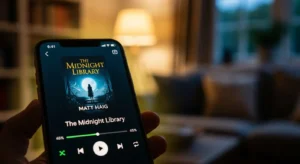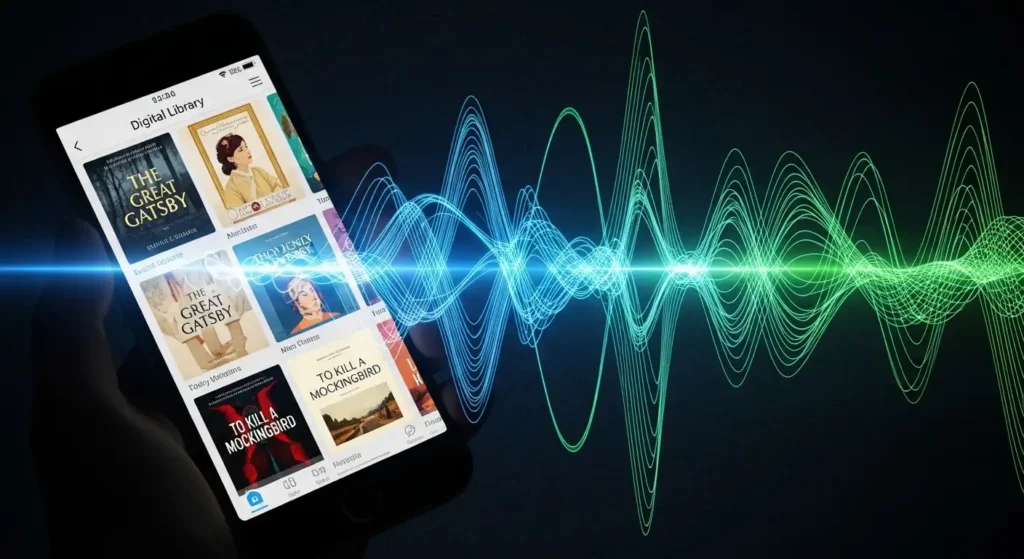In recent years, the way we read has changed dramatically. While physical books and eBooks remain popular, the audiobook revolution has reshaped how people consume stories. But in 2025, a new era has arrived—immersive audiobooks. These productions go far beyond simple narration. They blend cinematic soundscapes, music, and full casts to deliver a truly multidimensional storytelling experience. For readers, publishers, and creators alike, this trend is redefining what it means to “read.”
What Are Immersive Audiobooks?
 Traditional audiobooks feature a single narrator reading the text of a book from start to finish. Immersive audiobooks, on the other hand, are audio experiences crafted to evoke emotion and atmosphere. They combine rich sound design—such as ambient noises, background music, and special effects—with professional voice acting and sometimes interactive elements.
Traditional audiobooks feature a single narrator reading the text of a book from start to finish. Immersive audiobooks, on the other hand, are audio experiences crafted to evoke emotion and atmosphere. They combine rich sound design—such as ambient noises, background music, and special effects—with professional voice acting and sometimes interactive elements.
Some immersive productions allow listeners to make narrative choices, turning a story into a branching experience similar to an audio game. Others integrate 3D spatial sound so that the listener feels surrounded by the environment—waves crashing on one side, footsteps echoing behind, dialogue coming from multiple directions. The result is a deeper, more vivid engagement with the story world.
Why Immersive Audiobooks Are Gaining Popularity
Several factors are fueling the rise of immersive audiobooks in 2025:
- Advances in audio technology: Streaming platforms now support high-fidelity and 3D spatial audio, enabling immersive sound design to be easily delivered to mobile devices.
- Shifting consumer habits: Many readers multitask during commutes, workouts, or household chores. Immersive audio offers entertainment that feels more engaging than passive listening.
- Creative experimentation: Authors, studios, and platforms are collaborating with sound engineers and voice actors to build new storytelling formats that rival film and gaming in depth.
- Rising demand for accessibility: Audiobooks make stories accessible to those with visual impairments or reading difficulties, and immersive formats make the experience even more inclusive and enjoyable.
Examples of Immersive Audiobook Experiences
Several platforms are leading this transformation:
- Audible Originals: Productions like “The Sandman” by Neil Gaiman feature star-studded casts, cinematic sound design, and layered music to transport listeners into the world of the story.
- Spotify Audiobooks: Spotify’s 2025 updates now support 3D audio channels, allowing creators to produce dynamic audio dramas with enhanced directionality.
- Storytel and Realm: These platforms blur the line between podcasts and audiobooks, releasing serialized, sound-designed fiction episodes that mimic television storytelling in audio form.
These examples demonstrate how immersive audiobooks bridge multiple mediums—mixing literature, film, and gaming into one format.
How Immersive Audiobooks Benefit Readers
Listeners often describe immersive audiobooks as emotionally transporting. Because the combination of voice, sound, and atmosphere activates imagination on multiple levels, readers feel more connected to the story. Here are some benefits:
- Enhanced visualization: Background effects and music help listeners picture scenes vividly, even without a screen.
- Increased emotional depth: Music cues can heighten suspense, tenderness, or excitement, similar to a film score.
- Stronger memory retention: Studies suggest that multi-sensory input—sound plus story—helps listeners remember plot details more clearly.
- Accessibility for all: Readers with dyslexia or visual impairments can experience stories fully through sound alone.
Many audiobook fans also report that immersive soundscapes help them focus, turning reading into a meditative escape from screens and daily noise.
Why Authors and Publishers Are Embracing the Format
 For creators, immersive audiobooks represent a new creative and commercial opportunity. Publishers are discovering that listeners are willing to pay premium prices for high-quality productions. Authors enjoy seeing their stories interpreted in richer, more cinematic ways. This has sparked collaborations between publishing houses, audio producers, and even Hollywood sound engineers.
For creators, immersive audiobooks represent a new creative and commercial opportunity. Publishers are discovering that listeners are willing to pay premium prices for high-quality productions. Authors enjoy seeing their stories interpreted in richer, more cinematic ways. This has sparked collaborations between publishing houses, audio producers, and even Hollywood sound engineers.
Small indie authors also benefit. Thanks to affordable AI-powered sound tools and audio-editing software, it’s now possible to produce professional-grade immersive experiences without a massive studio budget. This democratization allows a wider range of voices to enter the space.
Challenges of the Immersive Format
Despite its promise, immersive audiobook production poses unique challenges:
- Cost and complexity: Multi-actor casts, sound mixing, and 3D audio mastering require significant investment.
- Creative balance: Overuse of effects or music can overwhelm the narrative rather than enhance it. Striking the right balance between clarity and immersion takes skill.
- Platform limitations: Not all audiobook services support spatial audio, and some devices may down-mix the sound, reducing the intended effect.
- Licensing and rights: As audio productions become more complex, copyright management for sound libraries, actors, and music adds legal hurdles.
Nevertheless, as technology matures and listener appetite grows, these obstacles are gradually being addressed through better production pipelines and new audio distribution standards.
The Future of Immersive Storytelling
Immersive audiobooks are just one piece of a larger shift toward multisensory storytelling. In the near future, expect to see convergence between audiobooks, podcasts, and virtual-reality experiences. Some publishers are already exploring mixed-reality tie-ins, where a listener can switch seamlessly from an immersive audio episode to a visual scene in augmented reality.
For readers, this evolution means stories can be experienced anywhere—walking in a park, driving to work, or relaxing at home. Books are no longer confined to pages or screens; they’re becoming living soundscapes that travel with us.
Environmental and Accessibility Advantages
Interestingly, immersive audiobooks also support sustainability and accessibility goals. Unlike print editions, they require no paper or shipping. Additionally, inclusive design ensures that stories reach a wider audience, regardless of reading ability or visual constraints. This makes them a responsible choice for both publishers and consumers seeking eco-friendly entertainment.
Tips for First-Time Immersive Listeners
If you’re new to immersive audiobooks, here’s how to get started:
- Choose the right platform: Apps like Audible, Storytel, and Realm now label immersive or 3D-audio productions clearly. Look for “Full Cast” or “3D Sound.”
- Use quality headphones: Spatial sound is best experienced through stereo or over-ear headphones that can capture directional effects.
- Experiment with genres: Try thrillers, fantasy, or science fiction first—these often feature the richest sound design.
- Make it a ritual: Set aside time to listen without distraction; the immersive format rewards attention much like reading a print book.
Internal Links You Might Add
Conclusion
Immersive audiobooks mark the next frontier in how we connect with stories. They blend art, technology, and imagination in ways that were once impossible. As the boundaries between reading, listening, and visual media blur, the simple act of “reading a book” is evolving into something entirely new—an experience that surrounds us, engages our senses, and stays with us long after the final chapter.
For readers, this means deeper connection and richer escapism. For authors, it’s a chance to reimagine storytelling itself. The future of books sounds brighter—and more immersive—than ever.
